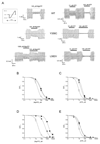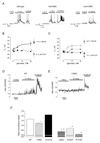A rare mutation in ABCC8/SUR1 leading to altered ATP-sensitive K+ channel activity and beta-cell glucose sensing is associated with type 2 diabetes in adults
- PMID: 18346985
- PMCID: PMC6101196
- DOI: 10.2337/db07-1547
A rare mutation in ABCC8/SUR1 leading to altered ATP-sensitive K+ channel activity and beta-cell glucose sensing is associated with type 2 diabetes in adults
Abstract
Objective: ATP-sensitive K(+) channels (K(ATP) channels) link glucose metabolism to the electrical activity of the pancreatic beta-cell to regulate insulin secretion. Mutations in either the Kir6.2 or sulfonylurea receptor (SUR) 1 subunit of the channel have previously been shown to cause neonatal diabetes. We describe here an activating mutation in the ABCC8 gene, encoding SUR1, that is associated with the development of type 2 diabetes only in adults.
Research design and methods: Recombinant K(ATP) channel subunits were expressed using pIRES2-based vectors in human embryonic kidney (HEK) 293 or INS1(832/13) cells and the subcellular distribution of c-myc-tagged SUR1 channels analyzed by confocal microscopy. K(ATP) channel activity was measured in inside-out patches and plasma membrane potential in perforated whole-cell patches. Cytoplasmic [Ca(2+)] was imaged using Fura-Red.
Results: A mutation in ABCC8/SUR1, leading to a Y356C substitution in the seventh membrane-spanning alpha-helix, was observed in a patient diagnosed with hyperglycemia at age 39 years and in two adult offspring with impaired insulin secretion. Single K(ATP) channels incorporating SUR1-Y356C displayed lower sensitivity to MgATP (IC(50) = 24 and 95 micromol/l for wild-type and mutant channels, respectively). Similar effects were observed in the absence of Mg(2+), suggesting an allosteric effect via associated Kir6.2 subunits. Overexpression of SUR1-Y356C in INS1(832/13) cells impaired glucose-induced cell depolarization and increased in intracellular free Ca(2+) concentration, albeit more weakly than neonatal diabetes-associated SUR1 mutants.
Conclusions: An ABCC8/SUR1 mutation with relatively minor effects on K(ATP) channel activity and beta-cell glucose sensing causes diabetes in adulthood. These data suggest a close correlation between altered SUR1 properties and clinical phenotype.
Figures





Similar articles
-
Mutations of the same conserved glutamate residue in NBD2 of the sulfonylurea receptor 1 subunit of the KATP channel can result in either hyperinsulinism or neonatal diabetes.Diabetes. 2011 Jun;60(6):1813-22. doi: 10.2337/db10-1583. Diabetes. 2011. PMID: 21617188 Free PMC article.
-
A heterozygous activating mutation in the sulphonylurea receptor SUR1 (ABCC8) causes neonatal diabetes.Hum Mol Genet. 2006 Jun 1;15(11):1793-800. doi: 10.1093/hmg/ddl101. Epub 2006 Apr 13. Hum Mol Genet. 2006. PMID: 16613899
-
Coexpression of the type 2 diabetes susceptibility gene variants KCNJ11 E23K and ABCC8 S1369A alter the ATP and sulfonylurea sensitivities of the ATP-sensitive K(+) channel.Diabetes. 2009 Oct;58(10):2419-24. doi: 10.2337/db09-0143. Epub 2009 Jul 8. Diabetes. 2009. PMID: 19587354 Free PMC article.
-
Update of mutations in the genes encoding the pancreatic beta-cell K(ATP) channel subunits Kir6.2 (KCNJ11) and sulfonylurea receptor 1 (ABCC8) in diabetes mellitus and hyperinsulinism.Hum Mutat. 2009 Feb;30(2):170-80. doi: 10.1002/humu.20838. Hum Mutat. 2009. PMID: 18767144 Review.
-
Mutations in the genes encoding the pancreatic beta-cell KATP channel subunits Kir6.2 (KCNJ11) and SUR1 (ABCC8) in diabetes mellitus and hyperinsulinism.Hum Mutat. 2006 Mar;27(3):220-31. doi: 10.1002/humu.20292. Hum Mutat. 2006. PMID: 16416420 Review.
Cited by
-
Imaging Meets Cytometry: Analyzing Heterogeneous Functional Microscopic Data from Living Cell Populations.J Imaging. 2021 Jan 13;7(1):9. doi: 10.3390/jimaging7010009. J Imaging. 2021. PMID: 34460580 Free PMC article.
-
Disallowance of Acot7 in β-Cells Is Required for Normal Glucose Tolerance and Insulin Secretion.Diabetes. 2016 May;65(5):1268-82. doi: 10.2337/db15-1240. Epub 2016 Feb 9. Diabetes. 2016. PMID: 26861785 Free PMC article.
-
Genetic Testing of Maturity-Onset Diabetes of the Young Current Status and Future Perspectives.Front Endocrinol (Lausanne). 2018 May 17;9:253. doi: 10.3389/fendo.2018.00253. eCollection 2018. Front Endocrinol (Lausanne). 2018. PMID: 29867778 Free PMC article. Review.
-
Inferring gene-phenotype associations via global protein complex network propagation.PLoS One. 2011;6(7):e21502. doi: 10.1371/journal.pone.0021502. Epub 2011 Jul 25. PLoS One. 2011. PMID: 21799737 Free PMC article.
-
Genetic variants in potassium channels are associated with type 2 diabetes in a Mongolian population.J Diabetes. 2012 Sep;4(3):238-42. doi: 10.1111/j.1753-0407.2011.00177.x. J Diabetes. 2012. PMID: 22151254 Free PMC article.
References
-
- Ashcroft FM. K(ATP) channels and insulin secretion: a key role in health and disease. Biochem Soc Trans. 2006;34:243–246. - PubMed
-
- Rutter GA. Visualising insulin secretion. The Minkowski Lecture 2004. Diabetologia. 2004;47:1861–1872. - PubMed
-
- Babenko AP, Polak M, Cave H, Busiah K, Czernichow P, Scharfmann R, Bryan J, Aguilar-Bryan L, Vaxillaire M, Froguel P. Activating mutations in the ABCC8 gene in neonatal diabetes mellitus. N Engl J Med. 2006;355:456–466. - PubMed
-
- Ellard S, Flanagan SE, Girard CA, Patch AM, Harries LW, Parrish A, Edghill EL, Mackay DJ, Proks P, Shimomura K, Haberland H, et al. Permanent neonatal diabetes caused by dominant, recessive, or compound heterozygous SUR1 mutations with opposite functional effects. Am J Hum Genet. 2007;81:375–382. - PMC - PubMed
Publication types
MeSH terms
Substances
Grants and funding
LinkOut - more resources
Full Text Sources
Medical
Molecular Biology Databases
Miscellaneous

